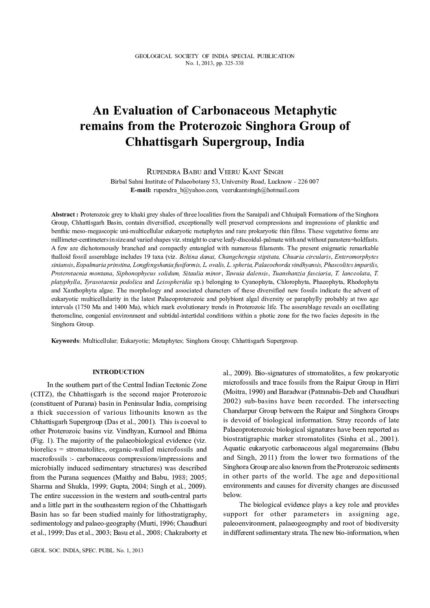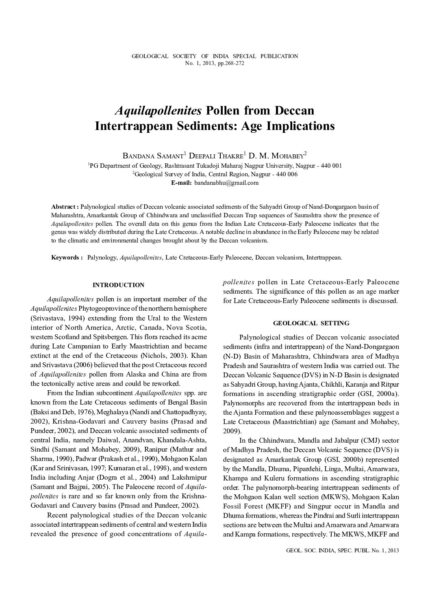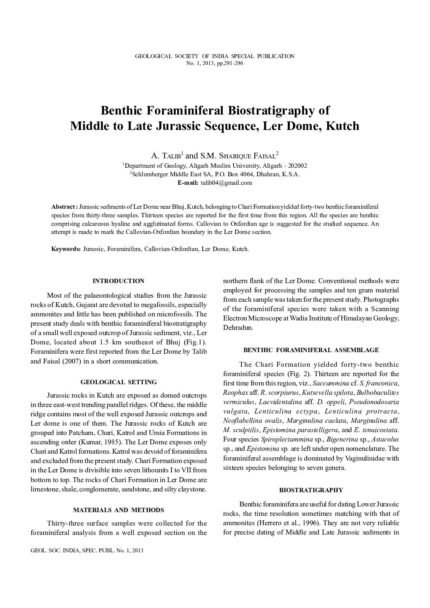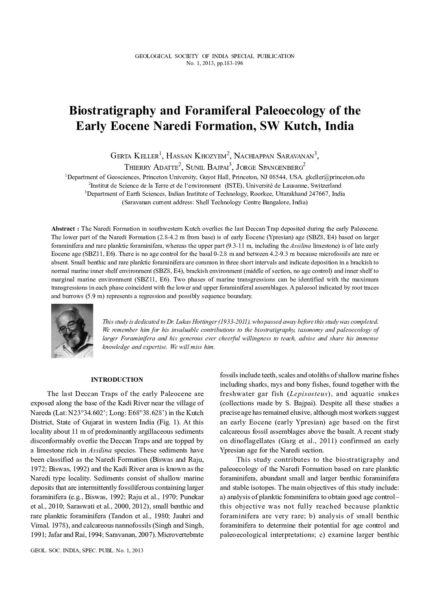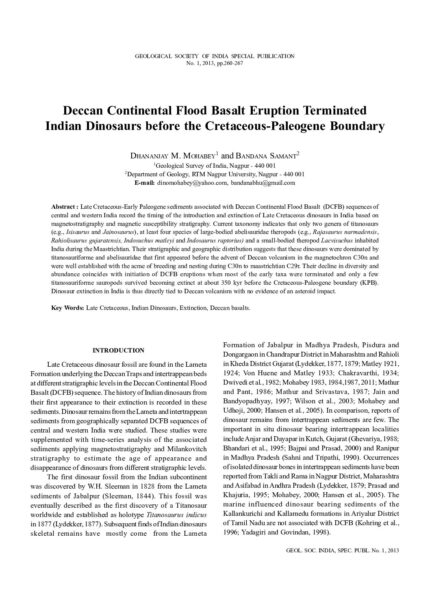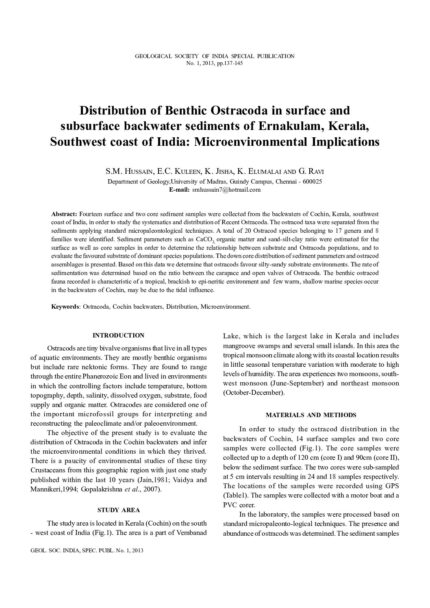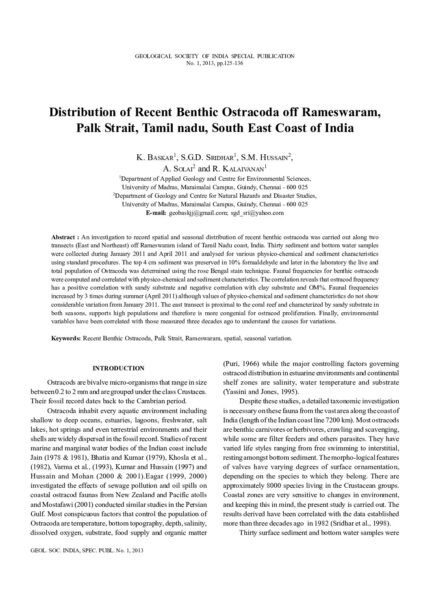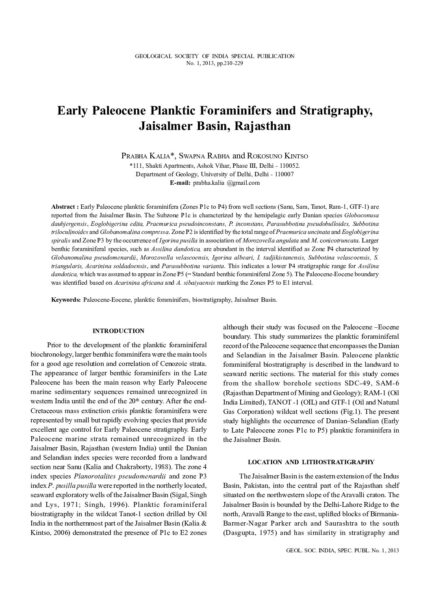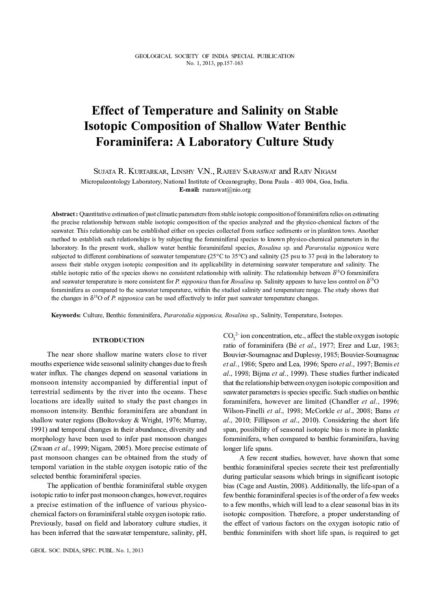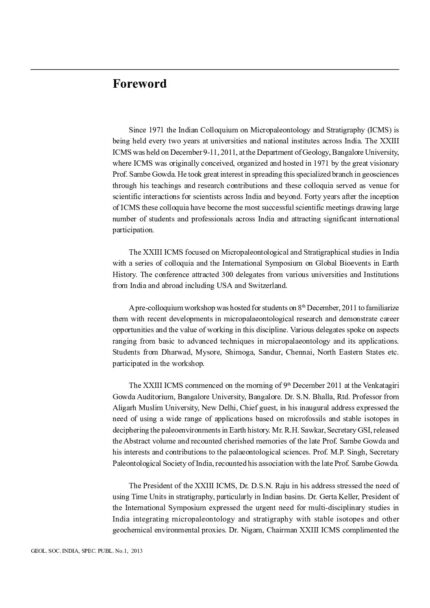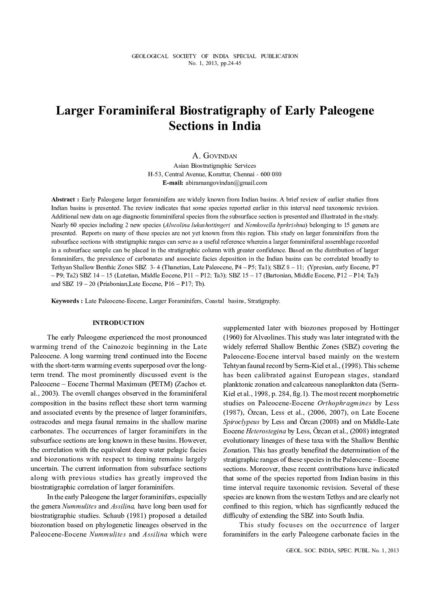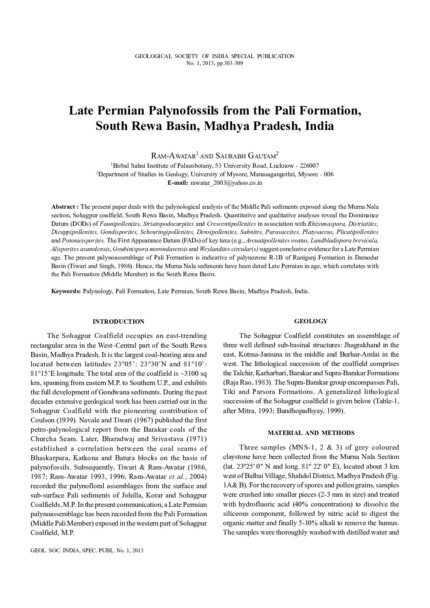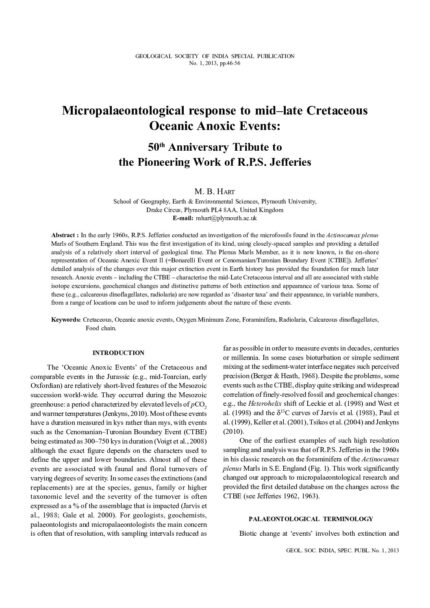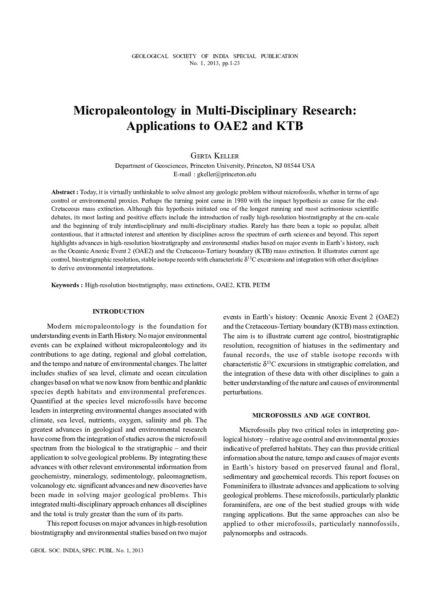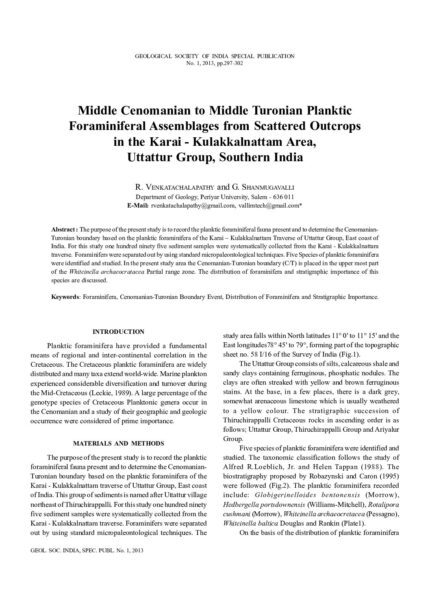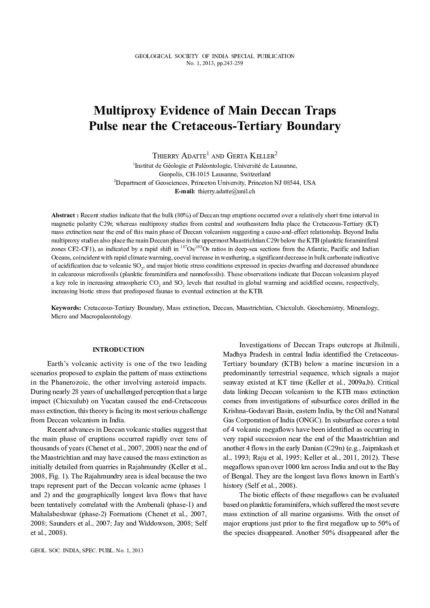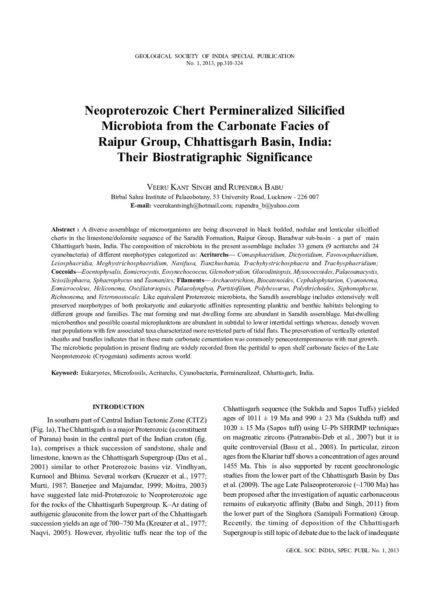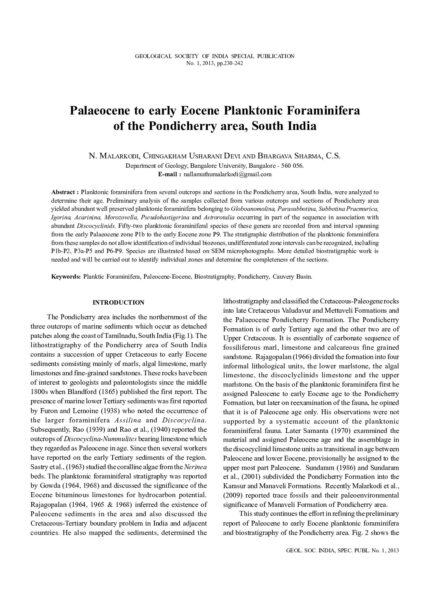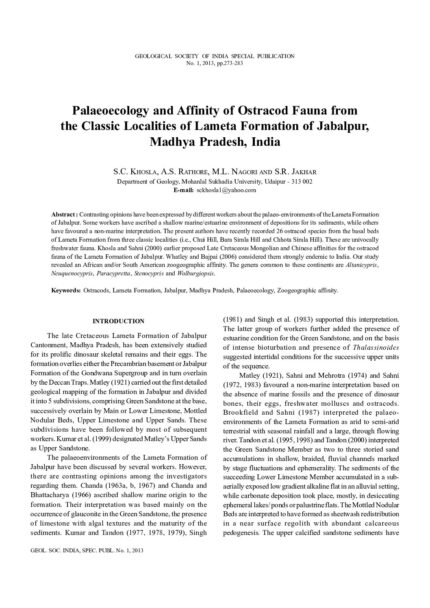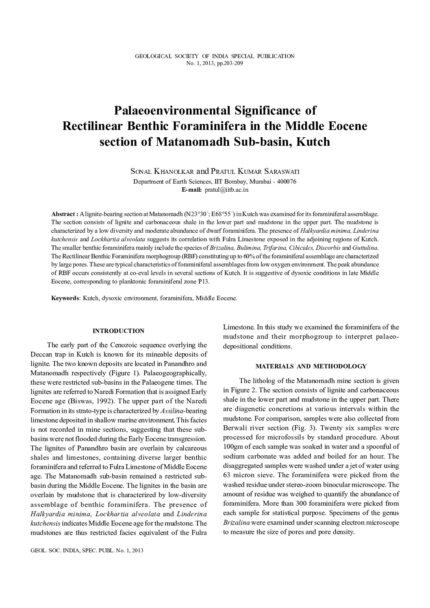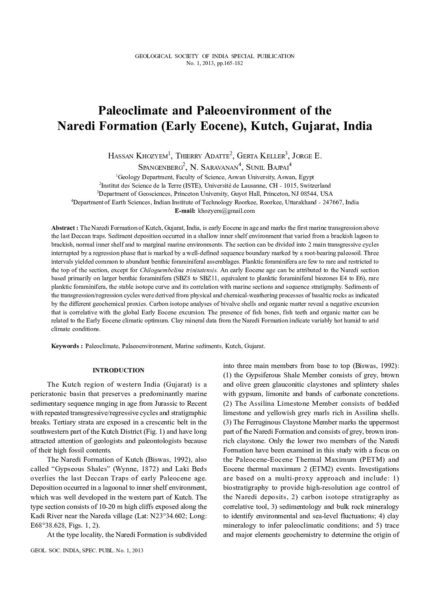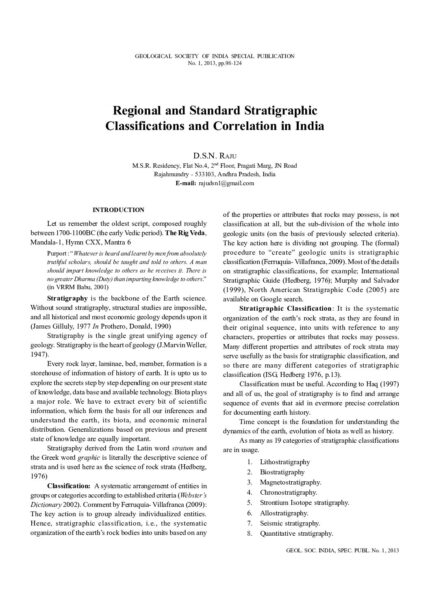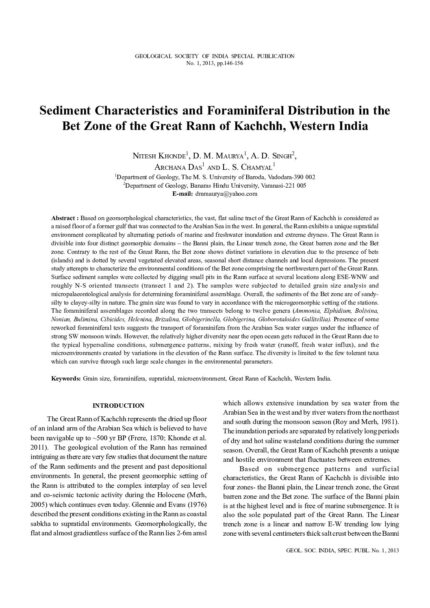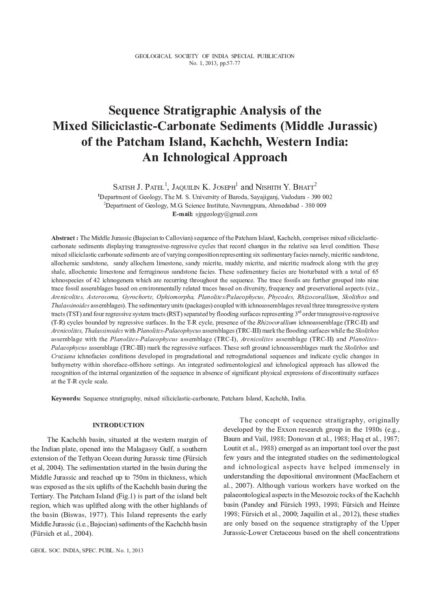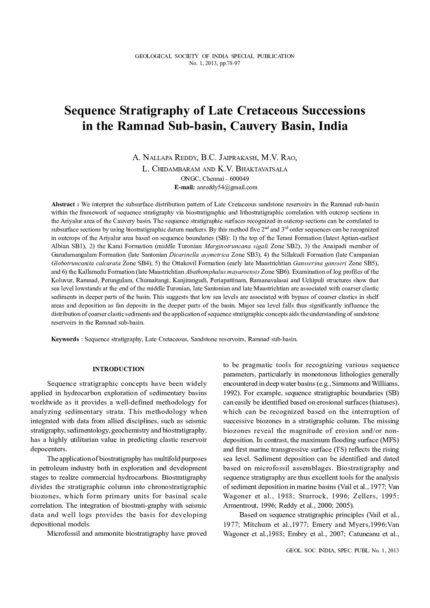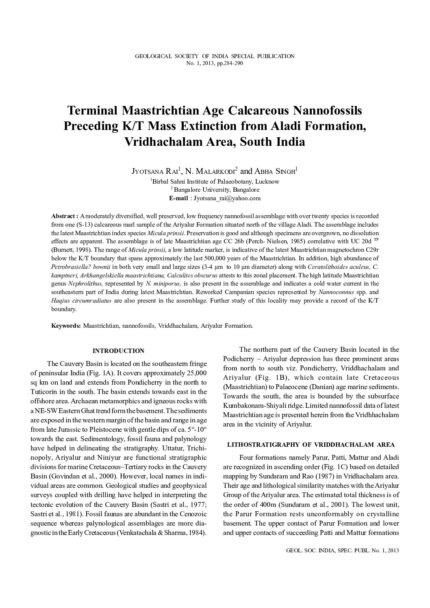SP-01: Proceedings of XXIII ICMS
An Evaluation of Carbonaceous Metaphytic remains from the Proterozoic Singhora Group of Chhattisgarh Supergroup, India
SKU:
C-63405
Proterozoic grey to khaki grey shales of three localities from the Saraipali and Chhuipali Formations of the Singhora Group, Chhattisgarh Basin, contain diversified, exceptionally well preserved compressions and impressions of planktic and benthic meso-megascopic uni-multicellular eukaryotic metaphytes and rare prokaryotic thin films. These vegetative forms are millimeter-centimeters in size and varied shapes viz. straight to curve leafy-discoidal-palmate with and without parastem = holdfasts. A few are dichotomously branched and compactly entangled with numerous filaments. The present enigmatic remarkable thalloid fossil assemblage includes 19 taxa (viz. Beltina danai, Changchengia stipitata, Chuaria circularis, Enteromorphytes siniansis, Eopalmaria prinstina, Longfengshania fusiformis, L. ovalis, L. spheria, Palaeochorda vindhyansis, Phascolites imparilis, Proterotaenia montana, Siphonophycus solidum, Sitaulia minor, Tawuia dalensis, Tuanshanzia fasciaria, T. lanceolata, T. platyphylla, Tyrasotaenia podolica and Leiospheridia sp.) belonging to Cyanophyta, Chlorophyta, Phaeophyta, Rhodophyta and Xanthophyta algae. The morphology and associated characters of these diversified new fossils indicate the advent of eukaryotic multicellularity in the latest Palaeoproterozoic and polybiont algal diversity or paraphylly probably at two age intervals (1750 Ma and 1400 Ma), which mark evolutionary trends in Proterozoic life. The assemblage reveals an oscillating theromcline, congenial environment and subtidal-intertidal conditions within a photic zone for the two facies deposits in the Singhora Group.
Aquilapollenites Pollen from Deccan Intertrappean Sediments: Age Implications
SKU:
C-63312
Palynological studies of Deccan volcanic associated sediments of the Sahyadri Group of Nand-Dongargaon basin of Maharashtra, Amarkantak Group of Chhindwara and unclassified Deccan Trap sequences of Saurashtra show the presence of Aquilapollenites pollen. The overall data on this genus from the Indian Late Cretaceous-Early Paleocene indicates that the genus was widely distributed during the Late Cretaceous. A notable decline in abundance in the Early Paleocene may be related to the climatic and environmental changes brought about by the Deccan volcanism.
Benthic Foraminiferal Biostratigraphy of Middle to Late Jurassic Sequence, Ler Dome, Kutch
SKU:
C-63316
Jurassic sediments of Ler Dome near Bhuj, Kutch, belonging to Chari Formation yielded forty-two benthic foraminiferal species from thirty-three samples. Thirteen species are reported for the first time from this region. All the species are benthic comprising calcareous hyaline and agglutinated forms. Callovian to Oxfordian age is suggested for the studied sequence. An attempt is made to mark the Callovian-Oxfordian boundary in the Ler Dome section.
Biostratigraphy and Foramiferal Paleoecology of the Early Eocene Naredi Formation, SW Kutch, India
SKU:
C-63303
The Naredi Formation in southwestern Kutch overlies the last Deccan Trap deposited during the early Paleocene. The lower part of the Naredi Formation (2.8-4.2 m from base) is of early Eocene (Ypresian) age (SBZ8, E4) based on larger foraminifera and rare planktic foraminifera, whereas the upper part (9.3-11 m, including the Assilina limestone) is of late early Eocene age (SBZ11, E6). There is no age control for the basal 0-2.8 m and between 4.2-9.3 m because microfossils are rare or absent. Small benthic and rare planktic foraminifera are common in three short intervals and indicate deposition in a brackish to normal marine inner shelf environment (SBZ8, E4), brackish environment (middle of section, no age control) and inner shelf to marginal marine environment (SBZ11, E6). Two phases of marine transgressions can be identified with the maximum transgressions in each phase coincident with the lower and upper foraminiferal assemblages. A paleosol indicated by root traces and burrows (5.9 m) represents a regression and possibly sequence boundary.
Deccan Continental Flood Basalt Eruption Terminated Indian Dinosaurs before the Cretaceous-Paleogene Boundary
SKU:
C-63310
Late Cretaceous-Early Paleogene sediments associated with Deccan Continental Flood Basalt (DCFB) sequences of central and western India record the timing of the introduction and extinction of Late Cretaceous dinosaurs in India based on magnetostratigraphy and magnetic susceptibility stratigraphy. Current taxonomy indicates that only two genera of titanosaurs (e.g., Isisaurus and Jainosaurus), at least four species of large-bodied abelisauridae theropods (e.g., Rajasaurus narmadensis, Rahiolisaurus gujaratensis, Indosuchus matleyi and Indosaurus raptorius) and a small-bodied theropod Laevisuchus inhabited India during the Maastrichtian. Their stratigraphic and geographic distribution suggests that these dinosaurs were dominated by titanosauriforme and abelisauridae that first appeared before the advent of Deccan volcanism in the magnetochron C30n and were well established with the acme of breeding and nesting during C30n to maastrichtian C29r. Their decline in diversity and abundance coincides with initiation of DCFB eruptions when most of the early taxa were terminated and only a few titanosauriforme sauropods survived becoming extinct at about 350 kyr before the Cretaceous-Paleogene boundary (KPB). Dinosaur extinction in India is thus directly tied to Deccan volcanism with no evidence of an asteroid impact.
Distribution of Benthic Ostracoda in Surface and Subsurface Backwater Sediments of Ernakulam, Kerala, Southwest Coast of India: Microenvironmental Implications
SKU:
C-63297
Fourteen surface and two core sediment samples were collected from the backwaters of Cochin, Kerala, southwest coast of India, in order to study the systematics and distribution of Recent Ostracoda. The ostracod taxa were separated from the sediments applying standard micropaleontological techniques. A total of 20 Ostracod species belonging to 17 genera and 8 families were identified. Sediment parameters such as CaCO3, organic matter and sand-silt-clay ratio were estimated for the surface as well as core samples in order to determine the relationship between substrate and Ostracoda populations, and to evaluate the favoured substrate of dominant species populations. The down core distribution of sediment parameters and ostracod assemblages is presented. Based on this data we determine that ostracods favour silty-sandy substrate environments. The rate of sedimentation was determined based on the ratio between the carapace and open valves of Ostracoda. The benthic ostracod fauna recorded is characteristic of a tropical, brackish to epi-neritic environment and few warm, shallow marine species occur in the backwaters of Cochin, may be due to the tidal influence.
Distribution of Recent Benthic Ostracoda off Rameswaram, Palk Strait, Tamil Nadu, South East Coast of India
SKU:
C-63296
An investigation to record spatial and seasonal distribution of recent benthic ostracoda was carried out along two transects (East and Northeast) off Rameswaram island of Tamil Nadu coast, India. Thirty sediment and bottom water samples were collected during January 2011 and April 2011 and analysed for various physico-chemical and sediment characteristics using standard procedures. The top 4 cm sediment was preserved in 10% formaldehyde and later in the laboratory the live and total population of Ostracoda was determined using the rose Bengal stain technique. Faunal frequencies for benthic ostracods were computed and correlated with physico-chemical and sediment characteristics. The correlation reveals that ostracod frequency has a positive correlation with sandy substrate and negative correlation with clay substrate and OM%. Faunal frequencies increased by 3 times during summer (April 2011) although values of physico-chemical and sediment characteristics do not show considerable variation from January 2011. The east transect is proximal to the coral reef and characterized by sandy substrate in both seasons, supports high populations and therefore is more congenial for ostracod proliferation. Finally, environmental variables have been correlated with those measured three decades ago to understand the causes for variations.
Early Paleocene Planktic Foraminifers and Stratigraphy, Jaisalmer Basin, Rajasthan
SKU:
C-63307
Early Paleocene planktic foraminifera (Zones P1c to P4) from well sections (Sanu, Sam, Tanot, Ram-1, GTF-1) are reported from the Jaisalmer Basin. The Subzone P1c is characterized by the hemipelagic early Danian species Globoconusa daubjergensis, Eoglobigerina edita, Praemurica pseudoinconstans, P. inconstans, Parasubbotina pseudobulloides, Subbotina triloculinoides and Globanomalina compressa. Zone P2 is identified by the total range of Praemurica uncinata and Eoglobigerina spiralis and Zone P3 by the occurrence of Igorina pusilla in association of Morozovella angulata and M. conicotruncata. Larger benthic foraminiferal species, such as Assilina dandotica, are abundant in the interval identified as Zone P4 characterized by Globanomalina pseudomenardii, Morozovella velascoensis, Igorina albeari, I. tadjikistanensis, Subbotina velascoensis, S. triangularis, Acarinina soldadoensis, and Parasubbotina varianta. This indicates a lower P4 stratigraphic range for Assilina dandotica, which was assumed to appear in Zone P5 (= Standard benthic foraminiferal Zone 5). The Paleocene-Eocene boundary was identified based on Acarinina africana and A. sibaiyaensis marking the Zones P5 to E1 interval.
Effect of Temperature and Salinity on Stable Isotopic Composition of Shallow Water Benthic Foraminifera: A Laboratory Culture Study
SKU:
C-63288
Quantitative estimation of past climatic parameters from stable isotopic composition of foraminifera relies on estimating the precise relationship between stable isotopic composition of the species analyzed and the physico-chemical factors of the seawater. This relationship can be established either on species collected from surface sediments or in plankton tows. Another method to establish such relationships is by subjecting the foraminiferal species to known physico-chemical parameters in the laboratory. In the present work, shallow water benthic foraminiferal species, Rosalina sp. and Pararotalia nipponica were subjected to different combinations of seawater temperature (25?C to 35?C) and salinity (25 psu to 37 psu) in the laboratory to assess their stable oxygen isotopic composition and its applicability in determining seawater temperature and salinity. The stable isotopic ratio of the species shows no consistent relationship with salinity. The relationship between ?18O foraminifera and seawater temperature is more consistent for P. nipponica than for Rosalina sp. Salinity appears to have less control on ?18O foraminifera as compared to the seawater temperature, within the studied salinity and temperature range. The study shows that the changes in ?18O of P. nipponica can be used effectively to infer past seawater temperature changes.
Larger Foraminiferal Biostratigraphy of Early Paleogene Sections in India
SKU:
C-63286
Early Paleogene larger foraminifera are widely known from Indian basins. A brief review of earlier studies from Indian basins is presented. The review indicates that some species reported earlier in this interval need taxonomic revision. Additional new data on age diagnostic foraminiferal species from the subsurface section is presented and illustrated in the study. Nearly 60 species including 2 new species (Alveolina lukashottingeri and Nemkovella bprkrishna) belonging to 15 genera are presented. Reports on many of these species are not yet known from this region. This study on larger foraminifers from the subsurface sections with stratigraphic ranges can serve as a useful reference wherein a larger foraminiferal assemblage recorded in a subsurface sample can be placed in the stratigraphic column with greater confidence. Based on the distribution of larger foraminifers, the prevalence of carbonates and associate facies deposition in the Indian basins can be correlated broadly to Tethyan Shallow Benthic Zones SBZ 3-4 (Thanetian, Late Paleocene, P4-P5; Ta1); SBZ 8-11; (Ypresian, early Eocene, P7-P9; Ta2) SBZ 14-15 (Lutetian, Middle Eocene, P11-P12; Ta3); SBZ 15-17 (Bartonian, Middle Eocene, P12-P14; Ta3) and SBZ 19-20 (Priabonian,Late Eocene, P16-P17; Tb).
Late Permian Palynofossils from the Pali Formation, South Rewa Basin, Madhya Pradesh, India
SKU:
C-63319
The present paper deals with the palynological analysis of the Middle Pali sediments exposed along the Murna Nala section, Sohagpur coalfield, South Rewa Basin, Madhya Pradesh. Quantitative and qualitative analyses reveal the Dominance Datum (DODs) of Faunipollenites, Striatopodocarpites and Crescentipollenites in association with Rhizomaspora, Distriatites, Dicappipollenites, Gondisporites, Scheuringipollenites, Densipollenites, Sahnites, Parasaccites, Platysaccus, Plicatipollenites and Potonieisporites. The First Appearance Datum (FADs) of key taxa (e.g., Arcuatipollenites ovatus, Lundbladispora brevicula, Alisporites asanolensis, Goubinispora morondavensis and Weylandites circularis) suggest conclusive evidence for a Late Permian age. The present palynoassemblage of Pali Formation is indicative of palynozone R-1B of Raniganj Formation in Damodar Basin (Tiwari and Singh, 1986). Hence, the Murna Nala sediments have been dated Late Permian in age, which correlates with the Pali Formation (Middle Member) in the South Rewa Basin.
Micropalaeontological Response To Mid-Late Cretaceous Oceanic Anoxic Events: 50th Anniversary Tribute to the Pioneering Work Of R.P.S. Jefferies
SKU:
C-63290
In the early 1960s, R.P.S. Jefferies conducted an investigation of the microfossils found in the Actinocamax plenus Marls of Southern England. This was the first investigation of its kind, using closely-spaced samples and providing a detailed analysis of a relatively short interval of geological time. The Plenus Marls Member, as it is now known, is the on-shore representation of Oceanic Anoxic Event ll (=Bonarelli Event or Cenomanian/Turonian Boundary Event [CTBE]). Jefferies' detailed analysis of the changes over this major extinction event in Earth history has provided the foundation for much later research. Anoxic events - including the CTBE - characterise the mid-Late Cretaceous interval and all are associated with stable isotope excursions, geochemical changes and distinctive patterns of both extinction and appearance of various taxa. Some of these (e.g., calcareous dinoflagellates, radiolaria) are now regarded as 'disaster taxa' and their appearance, in variable numbers, from a range of locations can be used to inform judgements about the nature of these events.
Micropaleontology in Multi-Disciplinary Research: Applications to OAE2 and KTB
SKU:
C-63279
Today, it is virtually unthinkable to solve almost any geologic problem without microfossils, whether in terms of age control or environmental proxies. Perhaps the turning point came in 1980 with the impact hypothesis as cause for the end- Cretaceous mass extinction. Although this hypothesis initiated one of the longest running and most acrimonious scientific debates, its most lasting and positive effects include the introduction of really high-resolution biostratigraphy at the cm-scale and the beginning of truly interdisciplinary and multi-disciplinary studies. Rarely has there been a topic so popular, albeit contentious, that it attracted interest and attention by disciplines across the spectrum of earth sciences and beyond. This report highlights advances in high-resolution biostratigraphy and environmental studies based on major events in Earth's history, such as the Oceanic Anoxic Event 2 (OAE2) and the Cretaceous-Tertiary boundary (KTB) mass extinction. It illustrates current age control, biostratigraphic resolution, stable isotope records with characteristic ?13C excursions and integration with other disciplines to derive environmental interpretations.
Middle Cenomanian to Middle Turonian Planktic Foraminiferal Assemblages from Scattered Outcrops in the Karai – Kulakkalnattam Area, Uttattur Group, Southern India
SKU:
C-63318
The purpose of the present study is to record the planktic foraminiferal fauna present and to determine the Cenomanian- Turonian boundary based on the planktic foraminifera of the Karai - Kulakkalnattam Traverse of Uttattur Group, East coast of India. For this study one hundred ninety five sediment samples were systematically collected from the Karai - Kulakkalnattam traverse. Foraminifers were separated out by using standard micropaleontological techniques. Five Species of planktic foraminifera were identified and studied. In the present study area the Cenomanian-Turonian boundary (C/T) is placed in the upper most part of the Whiteinella archaeocratacea Partial range zone. The distribution of foraminifera and stratigraphic importance of this species are discussed.
Multiproxy Evidence of Main Deccan Traps Pulse near the Cretaceous-Tertiary Boundary
SKU:
C-63309
Recent studies indicate that the bulk (80%) of Deccan trap eruptions occurred over a relatively short time interval in magnetic polarity C29r, whereas multiproxy studies from central and southeastern India place the Cretaceous-Tertiary (KT) mass extinction near the end of this main phase of Deccan volcanism suggesting a cause-and-effect relationship. Beyond India multiproxy studies also place the main Deccan phase in the uppermost Maastrichtian C29r below the KTB (planktic foraminiferal zones CF2-CF1), as indicated by a rapid shift in 187Os/188Os ratios in deep-sea sections from the Atlantic, Pacific and Indian Oceans, coincident with rapid climate warming, coeval increase in weathering, a significant decrease in bulk carbonate indicative of acidification due to volcanic SO2, and major biotic stress conditions expressed in species dwarfing and decreased abundance in calcareous microfossils (planktic foraminifera and nannofossils). These observations indicate that Deccan volcanism played a key role in increasing atmospheric CO2 and SO2 levels that resulted in global warming and acidified oceans, respectively, increasing biotic stress that predisposed faunas to eventual extinction at the KTB.
Neoproterozoic Chert Permineralized Silicified Microbiota from the Carbonate Facies of Raipur Group, Chhattisgarh Basin, India: Their Biostratigraphic Significance
SKU:
C-63321
A diverse assemblage of microorganisms are being discovered in black bedded, nodular and lenticular silicified cherts in the limestone/dolomite sequence of the Saradih Formation, Raipur Group, Baradwar sub-basin - a part of main Chhattisgarh basin, India. The composition of microbiota in the present assemblage includes 33 genera (9 acritarchs and 24 cyanobacteria) of different morphotypes categorized as: Acritarchs - Comasphaeridium, Dictyotidium, Favososphaeridium, Leiosphaeridia, Meghystrichosphaeridium, Navifusa, Tianzhushania, Trachyhystrichosphaera and Trachysphaeridium; Coccoids - Eoentophysalis, Eomicrocystis, Eosynechococcus, Glenobotrydion, Gloeodiniopsis, Myxococcoides, Palaeoanacystis, Scissilisphaera, Sphaerophycus and Tasmanites; Filaments - Archaeotrichion, Biocatenoides, Cephalophytarion, Cyanonema, Eomicrocoleus, Heliconema, Oscillatoriopsis, Palaeolyngbya, Partitiofilum, Polybessurus, Polythrichoides, Siphonophycus, Richnonema, and Veteronostocale. Like equivalent Proterozoic microbiota, the Saradih assemblage includes extensively well preserved morphotypes of both prokaryotic and eukaryotic affinities representing planktic and benthic habitats belonging to different groups and families. The mat forming and mat dwelling forms are abundant in Saradih assemblage. Mat-dwelling microbenthos and possible coastal microplanktons are abundant in subtidal to lower intertidal settings whereas, densely woven mat populations with few associated taxa characterized more restricted parts of tidal flats. The preservation of vertically oriented sheaths and bundles indicates that in these mats carbonate cementation was commonly penecontemporaneous with mat growth. The microbiotic population in present finding are widely recorded from the peritidal to open shelf carbonate facies of the Late Neoproterozoic (Cryogenian) sediments across world.
Palaeocene to Early Eocene Planktonic Foraminifera of the Pondicherry Area, South India
SKU:
C-63308
Planktonic foraminifera from several outcrops and sections in the Pondicherry area, South India, were analyzed to determine their age. Preliminary analysis of the samples collected from various outcrops and sections of Pondicherry area yielded abundant well preserved planktonic foraminifera belonging to Globoanomolina, Parasubbotina, Subbotina Praemurica, Igorina, Acarinina, Morozovella, Pseudohastigerina and Astrorotalia occurring in part of the sequence in association with abundant Discocyclinids. Fifty-two planktonic foraminiferal species of these genera are recorded from and interval spanning from the early Palaeocene zone P1b to the early Eocene zone P9. The stratigraphic distribution of the planktonic foraminifera from these samples do not allow identification of individual biozones, undifferentiated zone intervals can be recognized, including P1b-P2, P3a-P5 and P6-P9. Species are illustrated based on SEM microphotographs. More detailed biostratigraphic work is needed and will be carried out to identify individual zones and determine the completeness of the sections.
Palaeoecology and Affinity of Ostracod Fauna from the Classic Localities of Lameta Formation of Jabalpur, Madhya Pradesh, India
SKU:
C-63313
Contrasting opinions have been expressed by different workers about the palaeo-environments of the Lameta Formation of Jabalpur. Some workers have ascribed a shallow marine/estuarine environment of depositions for its sediments, while others have favoured a non-marine interpretation. The present authors have recently recorded 26 ostracod species from the basal beds of Lameta Formation from three classic localities (i.e., Chui Hill, Bara Simla Hill and Chhota Simla Hill). These are univocally freshwater fauna. Khosla and Sahni (2000) earlier proposed Late Cretaceous Mongolian and Chinese affinities for the ostracod fauna of the Lameta Formation of Jabalpur. Whatley and Bajpai (2006) considered them strongly endemic to India. Our study revealed an African and/or South American zoogeographic affinity. The genera common to these continents are Altanicypris, Neuquenocypris, Paracypretta, Stenocypris and Wolburgiopsis.
Palaeoenvironmental Significance of Rectilinear Benthic Foraminifera in the Middle Eocene Section of Matanomadh Sub-Basin, Kutch
SKU:
C-63306
A lignite-bearing section at Matanomadh (N23?30'; E68?55') in Kutch was examined for its foraminiferal assemblage. The section consists of lignite and carbonaceous shale in the lower part and mudstone in the upper part. The mudstone is characterized by a low diversity and moderate abundance of dwarf foraminifera. The presence of Halkyardia minima, Linderina kutchensis and Lockhartia alveolata suggests its correlation with Fulra Limestone exposed in the adjoining regions of Kutch. The smaller benthic foraminifera mainly include the species of Brizalina, Bulimina, Trifarina, Cibicides, Discorbis and Guttulina. The Rectilinear Benthic Foraminifera morphogroup (RBF) constituting up to 60% of the foraminiferal assemblage are characterized by large pores. These are typical characteristics of foraminiferal assemblages from low oxygen environment. The peak abundance of RBF occurs consistently at co-eval levels in several sections of Kutch. It is suggestive of dysoxic conditions in late Middle Eocene, corresponding to planktonic foraminiferal zone P13.
Paleoclimate and Paleoenvironment of the Naredi Formation (Early Eocene), Kutch, Gujarat, India
SKU:
C-63302
The Naredi Formation of Kutch, Gujarat, India, is early Eocene in age and marks the first marine transgression above the last Deccan traps. Sediment deposition occurred in a shallow inner shelf environment that varied from a brackish lagoon to brackish, normal inner shelf and to marginal marine environments. The section can be divided into 2 main transgressive cycles interrupted by a regression phase that is marked by a well-defined sequence boundary marked by a root-bearing paleosoil. Three intervals yielded common to abundant benthic foraminiferal assemblages. Planktic foraminifera are few to rare and restricted to the top of the section, except for Chiloguembelina trinitatensis. An early Eocene age can be attributed to the Naredi section based primarily on larger benthic foraminifera (SBZ8 to SBZ11, equivalent to planktic foraminiferal biozones E4 to E6), rare planktic foraminifera, the stable isotope curve and its correlation with marine sections and sequence stratigraphy. Sediments of the transgression/regression cycles were derived from physical and chemical-weathering processes of basaltic rocks as indicated by the different geochemical proxies. Carbon isotope analyses of bivalve shells and organic matter reveal a negative excursion that is correlative with the global Early Eocene excursion. The presence of fish bones, fish teeth and organic matter can be related to the Early Eocene climatic optimum. Clay mineral data from the Naredi Formation indicate variably hot humid to arid climate conditions.
Sediment Characteristics and Foraminiferal Distribution in the Bet Zone of the Great Rann of Kachchh, Western India
SKU:
C-63299
Based on geomorphological characteristics, the vast, flat saline tract of the Great Rann of Kachchh is considered as a raised floor of a former gulf that was connected to the Arabian Sea in the west. In general, the Rann exhibits a unique supratidal environment complicated by alternating periods of marine and freshwater inundation and extreme dryness. The Great Rann is divisible into four distinct geomorphic domains - the Banni plain, the Linear trench zone, the Great barren zone and the Bet zone. Contrary to the rest of the Great Rann, the Bet zone shows distinct variations in elevation due to the presence of bets (islands) and is dotted by several vegetated elevated areas, seasonal short distance channels and local depressions. The present study attempts to characterize the environmental conditions of the Bet zone comprising the northwestern part of the Great Rann. Surface sediment samples were collected by digging small pits in the Rann surface at several locations along ESE-WNW and roughly N-S oriented transects (transect 1 and 2). The samples were subjected to detailed grain size analysis and micropalaeontological analysis for determining foraminiferal assemblage. Overall, the sediments of the Bet zone are of sandysilty to clayey-silty in nature. The grain size was found to vary in accordance with the microgeomorphic setting of the stations. The foraminiferal assemblages recorded along the two transects belong to twelve genera (Ammonia, Elphidium, Bolivina, Nonian, Bulimina, Cibicides, Helenina, Brizalina, Globigerinella, Globigerina, Globorotaloides Gallitellia). Presence of some reworked foraminiferal tests suggests the transport of foraminifera from the Arabian Sea water surges under the influence of strong SW monsoon winds. However, the relatively higher diversity near the open ocean gets reduced in the Great Rann due to the typical hypersaline conditions, submergence patterns, mixing by fresh water (runoff, fresh water influx), and the microenvironments created by variations in the elevation of the Rann surface. The diversity is limited to the few tolerant taxa which can survive through such large scale changes in the environmental parameters.
Sequence Stratigraphic Analysis Of the Mixed Siliciclastic-Carbonate Sediments (Middle Jurassic) Of the Patcham Island, Kachchh, Western India: An Ichnological Approach
SKU:
C-63292
The Middle Jurassic (Bajocian to Callovian) sequence of the Patcham Island, Kachchh, comprises mixed siliciclastic-carbonate sediments displaying transgressive-regressive cycles that record changes in the relative sea level condition. These mixed siliciclastic carbonate sediments are of varying composition representing six sedimentary facies namely, micritic sandstone, allochemic sandstone, sandy allochem limestone, sandy micrite, muddy micrite, and micritic mudrock along with the grey shale, allochemic limestone and ferruginous sandstone facies. These sedimentary facies are bioturbated with a total of 65 ichnospecies of 42 ichnogenera which are recurring throughout the sequence. The trace fossils are further grouped into nine trace fossil assemblages based on environmentally related traces based on diversity, frequency and preservational aspects (viz., Arenicolites, Asterosoma, Gyrochorte, Ophiomorpha, Planolites/Palaeophycus, Phycodes, Rhizocorallium, Skolithos and Thalassinoides assemblages). The sedimentary units (packages) coupled with ichnoassemblages reveal three transgressive system tracts (TST) and four regressive system tracts (RST) separated by flooding surfaces representing 3rd order transgressive-regressive (T-R) cycles bounded by regressive surfaces. In the T-R cycle, presence of the Rhizocorallium ichnoassemblage (TRC-II) and Arenicolites, Thalassinoides with Planolites-Palaeophycus assemblages (TRC-III) mark the flooding surfaces while the Skolithos assemblage with the Planolites-Palaeophycus assemblage (TRC-I), Arenicolites assemblage (TRC-II) and Planolites-Palaeophycus assemblage (TRC-III) mark the regressive surfaces. These soft ground ichnoassemblages mark the Skolithos and Cruziana ichnofacies conditions developed in progradational and retrogradational sequences and indicate cyclic changes in bathymetry within shoreface-offshore settings. An integrated sedimentological and ichnological approach has allowed the recognition of the internal organization of the sequence in absence of significant physical expressions of discontinuity surfaces at the T-R cycle scale.
Sequence Stratigraphy Of Late Cretaceous Successions In the Ramnad Sub-Basin, Cauvery Basin, India
SKU:
C-63294
We interpret the subsurface distribution pattern of Late Cretaceous sandstone reservoirs in the Ramnad sub-basin within the framework of sequence stratigraphy via biostratigraphic and lithostratigraphic correlation with outcrop sections in the Ariyalur area of the Cauvery basin. The sequence stratigraphic surfaces recognized in outcrop sections can be correlated to subsurface sections by using biostratigraphic datum markers. By this method five 2nd and 3rd order sequences can be recognized in outcrops of the Ariyalur area based on sequence boundaries (SB): 1) the top of the Terani Formation (latest Aptian-earliest Albian SB1), 2) the Karai Formation (middle Turonian Marginotruncana sigali Zone SB2), 3) the Anaipadi member of Garudamangalam Formation (late Santonian Dicarinella asymetrica Zone SB3), 4) the Sillakudi Formation (late Campanian Globotruncanita calcarata Zone SB4), 5) the Ottakovil Formation (early late Maastrichtian Gansserina gansseri Zone SB5), and 6) the Kallamedu Formation (late Maastrichtian Abathomphalus mayaroensis Zone SB6). Examination of log profiles of the Koluvur, Ramnad, Perungulam, Chumaitangi, Kanjirangudi, Periapattinam, Ramanavalasai and Uchipuli structures show that sea level lowstands at the end of the middle Turonian, late Santonian and late Maastrichtian are associated with coarser clastic sediments in deeper parts of the basin. This suggests that low sea levels are associated with bypass of coarser clastics in shelf areas and deposition as fan deposits in the deeper parts of the basin. Major sea level falls thus significantly influence the distribution of coarser clastic sediments and the application of sequence stratigraphic concepts aids the understanding of sandstone reservoirs in the Ramnad sub-basin.
Strontium Isotope Stratigraphy of the Naredi Formation, Kutch Basin, India
SKU:
C-63304
The Naredi Formation records the first marine transgression of the Cenozoic era in Kutch. Its age has remained equivocal and various workers have assigned different ages ranging from Late Palaeocene to Early and Middle Eocene. In this study we carried out strontium isotopic analysis of the foraminiferal shells of the Naredi Formation to determine its numerical age in order to resolve this controversy. The measured 87Sr/86Sr ratios, lying between 0.707727 and 0.707816, have been compared with the standard strontium isotope variation curve for the Cenozoic. Biostratigraphically, the formation ranges from shallow benthic zone SBZ 6 to SBZ 11 corresponding to planktonic foraminiferal zones P5 to P9 (Serra-Kiel et al., 1998). The biostratigraphically constrained Sr isotopic values indicate that the Naredi Formation is of Early Eocene age spanning from 50 to 55Ma.
Terminal Maastrichtian Age Calcareous Nannofossils Preceding K/T Mass Extinction from Aladi Formation, Vridhachalam Area, South India
SKU:
C-63314
A moderately diversified, well preserved, low frequency nannofossil assemblage with over twenty species is recorded from one (S-13) calcareous marl sample of the Ariyalur Formation situated north of the village Aladi. The assemblage includes the latest Maastrichtian index species Micula prinsii. Preservation is good and although specimens are overgrown, no dissolution effects are apparent. The assemblage is of late Maastrichtian age CC 26b (Perch-Nielsen, 1985) correlative with UC 20dTP (Burnett, 1998). The range of Micula prinsii, a low latitude marker, is indicative of the latest Maastrichtian magnetochron C29r below the K/T boundary that spans approximately the last 500,000 years of the Maastrichtian. In addition, high abundance of Petrobrasiella? bownii in both very small and large sizes (3-4 ?m to 10 im diameter) along with Ceratolithoides aculeus, C. kamptneri, Arkhangelskiella maastrichtiana, Calculites obscurus attests to this zonal placement. The high latitude Maastrichtian genus Nephrolithus, represented by N. miniporus, is also present in the assemblage and indicates a cold water current in the southeastern part of India during latest Maastrichtian. Reworked Campanian species represented by Nannoconnus spp. and Haqius circumradiatus are also present in the assemblage. Further study of this locality may provide a record of the K/T boundary.

